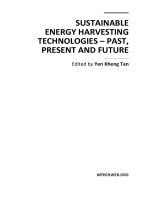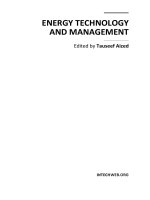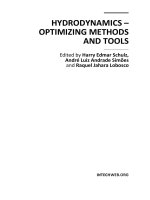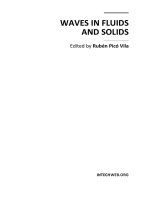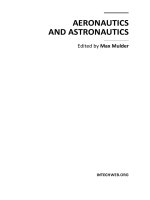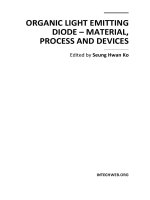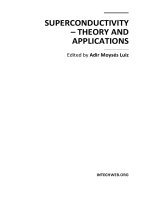Electric Machines and Drives Part 1 pot
Bạn đang xem bản rút gọn của tài liệu. Xem và tải ngay bản đầy đủ của tài liệu tại đây (748.64 KB, 20 trang )
ELECTRIC MACHINES
AND DRIVES
Edited by Miroslav Chomat
Electric Machines and Drives
Edited by Miroslav Chomat
Published by InTech
Janeza Trdine 9, 51000 Rijeka, Croatia
Copyright © 2011 InTech
All chapters are Open Access articles distributed under the Creative Commons
Non Commercial Share Alike Attribution 3.0 license, which permits to copy,
distribute, transmit, and adapt the work in any medium, so long as the original
work is properly cited. After this work has been published by InTech, authors
have the right to republish it, in whole or part, in any publication of which they
are the author, and to make other personal use of the work. Any republication,
referencing or personal use of the work must explicitly identify the original source.
Statements and opinions expressed in the chapters are these of the individual contributors
and not necessarily those of the editors or publisher. No responsibility is accepted
for the accuracy of information contained in the published articles. The publisher
assumes no responsibility for any damage or injury to persons or property arising out
of the use of any materials, instructions, methods or ideas contained in the book.
Publishing Process Manager Katarina Lovrecic
Technical Editor Teodora Smiljanic
Cover Designer Martina Sirotic
Image Copyright demarcomedia, 2010. Used under license from Shutterstock.com
First published February, 2011
Printed in India
A free online edition of this book is available at www.intechopen.com
Additional hard copies can be obtained from
Electric Machines and Drives, Edited by Miroslav Chomat
p. cm.
ISBN 978-953-307-548-8
free online editions of InTech
Books and Journals can be found at
www.intechopen.com
Chapter 1
Chapter 2
Chapter 3
Chapter 4
Chapter 5
Chapter 6
Chapter 7
Chapter 8
Preface IX
Premium Efficiency Motors 1
M. Benhaddadi, G. Olivier, R. Ibtiouen, J. Yelle, and J-F Tremblay
Electric Motor Performance Improvement Using
Auxiliary Windings and Capacitance Injection 25
Nicolae D.V
Magnetic Reluctance Method for Dynamical
Modeling of Squirrel Cage Induction Machines 41
Jalal Nazarzadeh and Vahid Naeini
Minimization of Losses in Converter-Fed
Induction Motors – Optimal Flux Solution 61
Waldiberto de Lima Pires, Hugo Gustavo Gomez Mello,
Sebastião Lauro Nau and Alexandre Postól Sobrinho
Sensorless Vector Control of Induction Motor Drive
- A Model Based Approach 77
Jogendra Singh Thongam and Rachid Beguenane
Feedback Linearization of Speed-Sensorless
Induction Motor Control with Torque Compensation 97
Cristiane Cauduro Gastaldini, Rodrigo Zelir Azzolin,
Rodrigo Padilha Vieira and Hilton Abílio Gründling
From Dynamic Modeling to Experimentation
of Induction Motor Powered by Doubly-Fed
Induction Generator by Passivity-Based Control 113
M. Becherif, A. Bensadeq, E. Mendes,
A. Henni, P. Lefley and M.Y Ayad
A RMRAC Parameter Identification
Algorithm Applied to Induction Machines 145
Rodrigo Z. Azzolin, Cristiane C. Gastaldini,
Rodrigo P. Vieira and Hilton A. Gründling
Contents
Contents
VI
Swarm Intelligence Based Controller for Electric
Machines and Hybrid Electric Vehicles Applications 161
Omar Hegazy, Amr Amin, and Joeri Van Mierlo
Operation of Active Front-End Rectifier
in Electric Drive under Unbalanced Voltage Supply 195
Miroslav Chomat
Space Vector PWM-DTC Strategy
for Single-Phase Induction Motor Control 217
Ademir Nied, José de Oliveira, Rafael de Farias Campos,
Seleme Isaac Seleme Jr. and Luiz Carlos de Souza Marques
The Space Vector Modulation PWM Control
Methods Applied on Four Leg Inverters 233
Kouzou A, Mahmoudi M.O and Boucherit M.S
Chapter 9
Chapter 10
Chapter 11
Chapter 12
Pref ac e
This book focuses on a very important and diverse fi eld of electric machines and
drives. The history of the electric machine, which is the keystone of electromechanical
energy conversion, dates back to the beginning of the nineteenth century. The names
of famous scientists, such as Michael Faraday, Joseph Henry or Nikola Tesla, are associ-
ated with the invention of the rotating electric machine. Electric drives have quickly
become an integral part of our everyday lives and we can hardly imagine our civiliza-
tion without them. Electric drives play a vital part in industry, transportation as well as
in modern households. If we counted the number of electric drives around every one of
us today, we would certainly be surprised how big the number is.
Since the invention of the fi rst electric machine, novel principles and designs have been
appearing and the properties and parameters of electric machines have been steadily
improving. The advent of power electronics and modern control circuitry at the end
of the twentieth century caused a revolution in the fi eld of electric drives. Nowadays,
when modern technologies are available and advanced materials and techniques com-
monly utilized, formerly inconceivable results can be achieved in the fi eld of modern
electric drives.
The twelve chapters of the book wri en by renowned authors, both academics and
practitioners, cover a large part of the fi eld of electric machines and drives. Various
types of electric machines, including three-phase and single-phase induction ma-
chines or doubly fed machines, are addressed. Most of the chapters focus on modern
control methods of induction-machine drives, such as vector and direct torque control.
Among others, the book addresses sensorless control techniques, modulation strate-
gies, parameter identifi cation, artifi cial intelligence, operation under harsh or failure
conditions, and modelling of electric or magnetic quantities in electric machines. Sev-
eral chapters give an insight into the problem of minimizing losses in electric ma-
chines and increasing the overall energy effi ciency of electric drives, which is currently
viewed as a priority.
I would like to express my gratitude to all the authors for their contributions, in which
they shared their valuable experience and knowledge with the readers. It was their im-
mense involvement that enabled the publication of this book. I would also like to thank
the InTech staff for their great eff ort and support in preparation of the book. I hope it
X
Preface
will benefi t the fi eld of electric machines and drives, provide the readers with a new
point of view on this interesting branch of electrical engineering and possibly initiate
many inventions and innovations in the future.
Miroslav Chomat
Institute of Thermomechanics AS CR, v.v.i.
Czech Republic
1
Premium Efficiency Motors
M. Benhaddadi
1
, G. Olivier
1
, R. Ibtiouen
2
, J. Yelle
3
, and J-F Tremblay
3
1
École Polytechnique de Montréal, dépt. de génie électrique, C.P. 6079
Succursale Centre-ville, Montréal, Québec, H3C 3A7
2
École Nationale Polytechnique d’Alger, dépt. de génie électrique, Avenue Pasteur
BP 182, El Harrach, 16200 Alger
3
Cégep du Vieux Montréal, dépt. Technologie de génie électrique, 255 Ontario-Est
Montréal, Québec, Canada H2X 1X6
1,3
Canada
2
Algérie
1. Introduction
Despite its considerable potential for energy savings, energy efficiency is still far from
realizing this potential. This is particularly true in the electrical sector (IEA, 2010). Why?
There is no probably just one single answer to this question. A consequential response
requires major multiform research and an analytical effort. No doubt that analysis of the
interaction between energy efficiency policies and energy efficiency performance of
economies accounts for a significant part of the effort.
In the future sustainable energy mix, a key role will be reserved for electricity, as GHG
emissions reduction in this sector has to be drastically reduced. In this option, obvious
conclusion is that large market penetration Premium motors needs a complex approach
with a combination of financial incentives and mandatory legal actions, as industry doesn’t
invest according to least life cycle costs (DOE, 2010).
This present work illustrates the induced enormous energy saving potential, permitted by
using high-efficiency motors. Furthermore, the most important barriers to larger high-
efficiency motors utilization are identified, and some incentives recommendations are given
to overcome identified impediments.
In the present work, experimental comparison of the performance characteristics of 3 hp
Premium efficiency motors from three different manufacturers has been presented. The
motors were tested according to Standard IEEE 112-B.
2. Energy, climate change and electricity
According to last report Intergovernmental Panel on Climate Change IPCC report (IPCC,
2007), the observed increase in global average temperatures since the mid-20th century is
very likely due to the observed increase in anthropogenic greenhouse gas concentrations.
Moreover, there is no doubt that discernible human influences now extend to other aspects
of climate, including ocean warming, continental-average temperatures, temperature
extremes and wind patterns. Stabilizing atmospheric carbon dioxide concentrations at twice
Electric Machines and Drives
2
the level of pre-industrial times is likely to require emissions reductions up to 90 % below
current levels by 2100. Clearly, reductions of this magnitude can be achieved only by taking
action globally and across all sectors of the economy. The electricity sector will undoubtedly
need to assume a major share of the weight, according to its contribution to overall
emissions estimated to be more 10 000 Mt (million tone) CO
2eq
per year.
As can be seen in fig.1, the electricity generation is dominantly produced from fossil fuels
(coal, oil, and gas), and today’s situation is the same as forty years ago (DOE, 2010). In the
last XXI world energy congress, it is highlighted that electricity generation will still depend
on fossil sources. In the meantime, according to (IEA, 2010), industry accounts for more 40 %
of the world 20 000 TWh (terawatt hours, or so called billion kilowatt hours) electricity
consumption, weighting more 4 000 Mt CO
2eq
per year. Within the industrial sector, motor
driven systems account for approximately 60% to 65% of the electricity consumed by North
American (RNC 2004, DOE 2010) and European Union industries. Implementing high
efficiency motor driven systems, or improving existing ones just by 1 to 2 %, could save up
to 100-200 TWh of electricity per year. This would significantly reduce the need for new
power plants. It would also reduce the production of greenhouse gases by more 100 million
CO
2eq
per year and push down the total environmental cost of electricity generation.
The worldwide electric motors above 1 hp can be estimated to be nowadays more 300
million units, with the annual sales of 34 million pieces. Typically, one-third of the electrical
energy use in the commercial sector and two-thirds of the industrial sector feed the electrical
motors (DOE, 2010). Moreover, the low voltage squirrel cage induction motor constitutes the
industry workhorse. In particular industrial sector such as the Canadian petroleum and
paper industry, the share of the energy used by electrical motors can reach 90% (RNC 2004).
Since induction motors are the largest electrical energy user, even small efficiency
improvements will result in very large energy savings and contribute to reduce greenhouse
gas emissions GHG. Furthermore, the declining resources combined environmental global
warming concerns and with increasing energy prices make energy efficiency an imperative
objective.
Fig. 1. Electricity generation by fuel
Premium Efficiency Motors
3
3. Motor losses segregation and efficiency
The impact of a motor in terms of energy and economical costs depends on its performance
during its lifetime. The motor performances are characterized by the efficiency with which it
converts electrical energy into mechanical energy.
In Standard IEEE 112-B the losses are segregated and the efficiency is estimated by the
following formula:
ΔP
str
= P
in
– P
out
– (ΔP
el1
+ ΔP
el2
+ ΔP
core
+ ΔP
mech
) (1)
Where the electric input power, P
in
, is measured with a power analyser and the output
power, P
out,
with a torque meter. The overall precision of efficiency assessment mainly
depends on the torque estimation, and with the improved accuracy of recent power
analysers and torque meters, this method can be considered accurate and reliable.
Motor efficiency is defined as a ratio motor mechanical output power and electrical input
power. Hence in order to have a motor perform better, it is important to reduce its losses.
The major motor losses are resistive losses in the stator and the rotor windings, and
magnetic losses (hysteresis and eddy current losses) in the cores. Other losses include
mechanical (bearing friction and ventilation), and stray load losses. High efficiency motor
losses relative distribution is not so different at low efficiency one’s; it’s more dependent on
the power. Their general distribution is illustrated in fig.2.
Fig. 2. Induction motor losses distribution
There are many ways to improve electric motor efficiency; the majority of them make the
motor larger in diameter or overall sizes and, of course, more expensive.
• Winding stator (∆P
el1
) and rotor (∆P
el2)
losses are due to currents flowing through the
stator windings and rotor bars. These losses can be reduced by decreasing the
conductor current density in the stator windings, in the rotor bars and in the end rings.
Using larger conductors lowers stator resistance, while the use of copper instead of
aluminum reduces rotor losses (Parasiliti et al. 2002). Another way of decreasing stator
losses is by reducing the number of turns. Unfortunately, this increases the starting
current and maximum torque, as worsen the power factor.
Electric Machines and Drives
4
• Magnetic losses ∆P
m
occurring in the stator and rotor laminations are caused by the
hysteresis and eddy current phenomena. These losses can be decreased by using better
grade magnetic steel, thinner laminations and by lowering the flux density (i.e larger
magnetic cores). The better grade of laminations steel are still relatively very expensive.
Cheaper manufacturing methods other than stamping are expected to become available
in the near future.
• Mechanical losses ∆P
mec
are due to bearing friction and cooling fan air resistance.
Improving the fan efficiency, the air flow and using low friction bearings result in a
more efficient design. As these losses are relatively small, the efficiency gain is small
too, but every improvement is welcome.
• Stray load losses ∆P
st
are due to leakage fluxes induced by load current, non-uniform
current distribution, mechanical air-gap imperfection…These losses can be reduced by
design optimisation and manufacturing method improvements.
As can be deducted, one of the most established methods of increasing motor efficiency is to
use higher quality materials, inexorably increasing the motor cost, as most high performance
materials are expensive materials. In a recurrent manner, the same problem of increased cost
holds true for better construction techniques, such as smaller air gaps, copper rather than
aluminum in the rotor construction, higher conductor slot fill, and segmented core stator
construction. The resulting increase in motor cost is evaluated to be between 15 % and 30 %.
4. Testing standards
In North America, the prevailing testing method is based on direct efficiency measurement
method, as described in the Institute of Electrical and Electronics Engineers (IEEE) “Standard
Test Procedure for Polyphase Induction Motors and Generators” IEEE 112-B and in its Canadian
CSA 390 adaptation. The standard first introduced in 1984 and updated in 2004, requires the
measurement of the mechanical power output and the electric input, and provide a value for
the motor losses, where the additional stray load losses are extrapolated from their total by
the following formula (1). So, the efficiency is extrapolated by:
12
=
+Δ +Δ +Δ +Δ +Δ
Pout Pout
η =
P
in Pout Pel Pel Pm Pmec Pst
(2)
In Europe, the prevailing testing method is based on an indirect efficiency measurement as
defined in IEC 34-2 standard “Rotating electrical machines – Part 2: Methods for
determining losses and efficiency of rotating electrical machinery from tests”. The standard
first introduced in 1972 and updated in 1997, attribute a fixed value, equal to o.5 % of input
power to the additional stray load losses.
These standards differ mainly by the method used to take into account the additional load
losses (Aoulkadi & Binder, 2008, Boglietti et al 2004, Nagorny et al. 2004, Elmeida et al.
2002…). Many papers have been published and some authors have illustrated, that IEC 34 –
2 has drawback with a noticeable influence on the testing of high efficiency motors, as the
efficiency of this motor type is overestimated, particularly in the small motor size cases.
Ultimately, standard IEC 34 – 2 was found to be unrealistic with its 0.5 % P
in
value for stray
losses (Aoulkadi & Binder, 2008, Renier et al. 1999, Boglietti et al 2004…). That is why, in
2007, IEC published a revised standard for efficiency classification no. 60034-2-1 which
includes a test procedure largely comparable to IEEE 112-B or CSA C390. Newly
Premium Efficiency Motors
5
harmonized standards for energy efficiency testing IEC 60034-2-1 can contribute to lowering
barriers in global trade for energy efficient motor systems.
5. Minimum energy performance standard MEPS and efficiency motor
classification
There are many different worldwide definitions for energy efficient motors, as until these
last years, there was no consensus on what really represents an energy efficient motor.
Technical barriers include non harmonized testing standards and efficiency classification. In
reality, the key mandatory instrument is minimum energy performance standards (MEPS).
5.1 MEPS in North America
On October 1992, US Congress voted law, Energy Policy Act EPAct, which mandates strict
energy efficiency standards for electrical appliances and equipment, including electric
motors. Motor MEPS were for the first time introduced in 1992 when all partners were
finally persuaded that voluntary measures are too slow, and no significant market
transformation towards more efficient motors was possible otherwise.
EPAct requires that the general purpose electric motors meet the higher nominal efficiency
requirements defined in the table of National manufacturer association NEMA Standard,
and the implementation of the motor MEPS went into effect in 1997.
The Canadian Standard association developed a Canadian standard in 1993, and updated it
in 1998. CAN/CSA C-390 set the requirement for minimum efficiency for new motors made
or sold in Canada at the same value as the NEMA energy-efficient level.
The Energy Policy Act EPAct-92 motors covered are:
• General purpose
• Definite or special purpose in a general purpose application
• Continuous duty
• 2, 4 & 6 Pole
• 1-200 HP
• 230/460/, 60 Hz
The Canadian standard was furthermore extended to 575 V and IEC motors, and included
75 % full load to reach maximum efficiency.
Some motors were not covered:
• Definite or special purpose in a non-general purpose application
• Slower speeds
• Inverter duty
• Multi-speed
• Totally enclosed air over TEAO, and totally enclosed not ventilated TENV
As a result of the mandatory standard that was endorsed as part of the EPAct-92, North
America had a motor standard foundation that leads the new century world.
In 2002, NEMA and Consortium for energy efficiency CEE established a voluntary NEMA
Premium level of efficiency, and the manufacturers began the next step in evolution with
the implementation on voluntary basis MEPS NEMA Premium efficiency motors. NEMA
premium efficiency standards (CEE 2007) have remained voluntary for a long period of 10
years. In spite of this, NEMA premium motors have been progressively gaining market
share, as the overall benefits of Premium motors is incommensurable (more reliable, last
Electric Machines and Drives
6
longer, have longer warranties, run more quietly and cooler and produce less waste heat
than their less-efficient counterparts). The trend is particularly well depicted in the work,
illustrated in fig. 3.
The evolution of MEPS based on NEMA Premium is now moving from voluntary basis to
legislated regulation, as the law implementation is awaited for December 2010. So, 1 –200
HP general purpose motors already covered by EPAct will change from NEMA MG-1, Table
12-11 Energy Efficient (Annex 1) to Table 12-12 NEMA Premium efficiencies levels (Annex
2), except for fire pump motors which remain at EPAct-92 level.
Moreover, the proposal expands the scope of enclosed 1-200 Hp motors, as several motor
types not previously covered by EPAct-92 must meet EPAct efficiency levels. The added
motors are:
• U-frame
• Design C
• Footless
• Close-coupled pump
• Vertical solid shaft normal thrust
• 8 poles
• All low voltages ≤ 600 V not previously covered, including IEC Metric frame motors
from 90 frames and up.
• 201 to 500 HP low voltage 2-8 pole general purpose motors, where Design B represent
something like ¾ of total range.
It’s appropriate to highlight that this additional coverage means that MEPS is extended to
more 90 %of the motors in the 1 to 200 Hp range, despite the fact that some manufacturers
expressed technical skepticism about meeting premium efficiency levels design C and 900
rpm motors.
Fig. 3. Efficiency trend 2001-2006 and efficiency expected 2008-2013
On the other hand, EISA does not apply to motors exported outside North America, as well
as EISA doesn’t contain any requirement to replace electric motors in use. In addition, the
Premium Efficiency Motors
7
law applies only to motors manufactured after December 19, 2010 and motors in inventory
on that date can be sold or used without any additional constraints, but some customers
may not probably want them.
Some Motor configurations are not covered by EISA law. These are:
• Design D with high slip
• Inverter duty with optimized windings for adjustable speed drives ASD use
• Customized OEM mounting
• Intermittent duty
• Integral with gearing or brake where motor cannot be used separately
• Submersible motors
• Single Phase motors
• DC motors
• Two-digit frames (48-56)
• Multi-speed
• Medium voltage motors
• Repaired motors
• TENV and TEAO enclosures
It’s relevant to notice that regulation concerning single phase and three-phase small (42/48
and 56 frame) motors is ready, as Department of energy (DOE 2010) published in 2010 its
final rule giving efficiency limits that must be meet by small general purpose electric
motors, starting from 2015. Nevertheless, NEMA doesn’t support regulation of this product,
as many questions are still not solved while small induction motor is continually losing
market part to switched reluctance and permanent magnet types.
5.2 New IEC standard
In 2007, IEC published a revised standard for efficiency testing no. 60034-2-1 which includes
a test procedure largely comparable to IEEE 112-B or CSA C390, and in September 2008 a
new standard no. 60034-30 for efficiency classification of electric motors.
New standard for efficiency classification is applicable to single speed, three-phase
induction motors with the following parameters:
• Power from 0.75 to 375 kW
• Voltage under 1000 V
• 50 and 60 Hz frequency
• 2, 4 and 6 poles
• Duty S1 or S3
• All IP1x to 6x and IC0x to 4x
• Networked
• All types of fixing, shaft extension, accessories
Some Motor configurations are not covered by IEC 60034-30. These are:
• Motors with reinforced isolation specifically designed for variable speed drives
applications
• Motors which are fully integrated in a machine and cannot be tested separately
Newly 2008 harmonized standard for energy efficiency class 60034-30-2008 follow
International Electrotechnical Commission (IEC) protocol and defines four induction motor
efficiency classes:
Electric Machines and Drives
8
• Super Premium efficiency level IE4
• Premium efficiency level IE3
• High efficiency level IE2
• Standard efficiency level IE1
It’s noticeable that, nowadays, Premium efficiency IE3 is the most efficient motor. Super
Premium efficiency IE4 is a future new generation motor. It is awaited that in average, the
losses reduction of IE4 should be 15 % compared to IE3. So, IE4 is not a standard in fact, but
just a level.
5.3 MEPS in EU and BRIC countries
In Europe, the European committee of manufacturers of electrical machines and power
electronics CEMEP has classified 2 & 4 pole 1-90 kW motors into three levels:
• High (EFF1),
• Improved (EFF2), and
• Standard efficiency (EFF3).
The CEMEP classification has induced substantial EFF3 motors reduction and EFF2 market
share promotion. Nevertheless, EFF1 market part is still modest. Meanwhile, European
Union is considering prohibiting the sale of motors that don’t meet EFF2 criteria in the near
2011 future.
The new EU MEPS system is based on the latest IEC standard, and it represents a significant
step towards worldwide harmonization of efficiency regulations.
The challenges that EU countries facing are:
• From June 16, 2011, motors shall not be less efficient than IE1 (i.e. EFF2) and EFF3
motors will be banned
• From January 1, 2015, motors with rated output of 7.5 to 375 kW shall not be less
efficient than IE2
• From January 1, 2017, motors with rated output of 7.5 to 375 kW shall not be less
efficient than IE3
• From January 1, 2017, all motors with rated 0.75 to 375 kW shall not be less efficient
than IE2 if equipped with adjustable speed drive (ASD).
BRIC countries (Brazil-Russia-India-China) motors and motor driven equipment are still
relatively less efficient. For example, the efficiency of over 80 % Chinese motors is 2-5 %
lower than international advanced ones. Chinese scientists consider that if efficiency of
motor systems could be raised to the North American level, then 150 TWh of electricity
would be saved each year. But China is making progress, by formulating a number of
policies, laws and regulations on energy conservation. Beginning this 2010 year, the MEPS
efficiency of newly added motors should reach international first-rate level Class 2, which is
equivalent to IE1, or EFF2.
At the present time, 10 countries with a half of global electricity demand have motor MEPS
endorsement. In the next two years, 15 new countries targeted for a next round until 2012 to
reach around 80% of global electricity demand.
As earlier mentioned, the International Electrotechnical Commission (IEC), a worldwide
organization for standardization comprising all national standards committees, defined in
IEC 60034-30 (2009) four efficiency classes for single-speed cage-induction motors, and
specified test procedures. It’s important to notice that the so-called IE4 Super Premium
Efficiency products are not commercially available yet, while lower efficiency motors in use
